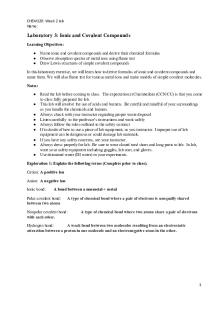SCHU4U1 Ionic Covalent lab PDF

| Title | SCHU4U1 Ionic Covalent lab |
|---|---|
| Author | Valentina Pham |
| Course | Chemistry |
| Institution | High School - Canada |
| Pages | 9 |
| File Size | 218.9 KB |
| File Type | |
| Total Downloads | 90 |
| Total Views | 142 |
Summary
Ionic/covalent lab report...
Description
Physical Properties of Ionic, Nonpolar & Polar Covalent Compounds Introduction The focus of this lab is to gain an understanding on how and why a compound’s name, structural formula, and physical properties exhibited through various lab tests determine its type of bond, being either ionic, polar, or nonpolar. The compounds being studied are road deicer (CaCl2 ), vinegar H O H O (CH3 COOH) , aspirin ( C ), and table sugar ( C ). The physical properties tests include melting 9 8 4 12 22 11 time, solubility in water (and additionally hot water if insoluble in room temperature water), solubility in methanol, and electrical conductivity. Ionic bonds are electrostatic forces of attraction that occur between oppositely charged ions. Ionic bonds are known to be one of the strongest electrostatic forces (with ΔEN ≥ 1.7) as they form crystal lattice structures in which the attraction between opposite charges is maximized, and repulsion is minimized. Covalent bonds are amongst the strongest electrostatic forces since it involves the sharing of electrons, known as bond pairs. This sharing of electrons is made possible because the two atoms involved have similar electronegativities (an atom’s affinity for electrons). Neither atom has the desire to donate or take an electron, rather they share. Within covalent bonds, one may further classify a molecule as polar or nonpolar. Polar molecules have electronegativity differences that are significant enough to cause an uneven distribution of electrons (0.4...
Similar Free PDFs

SCHU4U1 Ionic Covalent lab
- 9 Pages

Ionic and covalent bond lab
- 1 Pages

LAB Covalent - Ionic (Part 1)
- 5 Pages

Covalent and Ionic Compounds
- 5 Pages

Ionic and covalent bonding in Solids
- 11 Pages

Ionic - lab report
- 1 Pages
Popular Institutions
- Tinajero National High School - Annex
- Politeknik Caltex Riau
- Yokohama City University
- SGT University
- University of Al-Qadisiyah
- Divine Word College of Vigan
- Techniek College Rotterdam
- Universidade de Santiago
- Universiti Teknologi MARA Cawangan Johor Kampus Pasir Gudang
- Poltekkes Kemenkes Yogyakarta
- Baguio City National High School
- Colegio san marcos
- preparatoria uno
- Centro de Bachillerato Tecnológico Industrial y de Servicios No. 107
- Dalian Maritime University
- Quang Trung Secondary School
- Colegio Tecnológico en Informática
- Corporación Regional de Educación Superior
- Grupo CEDVA
- Dar Al Uloom University
- Centro de Estudios Preuniversitarios de la Universidad Nacional de Ingeniería
- 上智大学
- Aakash International School, Nuna Majara
- San Felipe Neri Catholic School
- Kang Chiao International School - New Taipei City
- Misamis Occidental National High School
- Institución Educativa Escuela Normal Juan Ladrilleros
- Kolehiyo ng Pantukan
- Batanes State College
- Instituto Continental
- Sekolah Menengah Kejuruan Kesehatan Kaltara (Tarakan)
- Colegio de La Inmaculada Concepcion - Cebu









